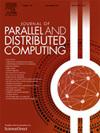嵌入式脚手架用于教学和评估基于探究的分布式系统动手实验
IF 3.4
3区 计算机科学
Q1 COMPUTER SCIENCE, THEORY & METHODS
引用次数: 0
摘要
背景信息技术教育必须培养对分布式系统的熟练程度,包括强大的动手实验技能,以满足社会和行业的需求。考虑到分布式系统的复杂性,任何向新手教授分布式系统的成功方法都必须有适当的框架,以确保学生获得所需的专业知识。目的在分布式系统课程中,我们提出了一种基于探究性实践实验的综合脚手架方法,该方法不仅指导了学习过程,而且指导了评估过程。该方法主要基于嵌入式框架,即明确的编码和实验里程碑以及预定义分数的开放性问题,但也有教师在需要额外帮助时提供的临时框架。方法我们将该方法应用于我校提供的“分布式网络系统”课题。我们比较了学生在三门学术课程中使用所提出的方法的表现,以及仍然使用前一种方法的三门课程。我们使用视觉表示和计划的方差分析(ANOVA)检验来验证我们定义为复杂对比的假设。我们发现,在使用新方法时,学生的表现在统计上有显着的改善,无论是在他们的作业成绩(F(1,75.364) = 17.770, p=6.85×10−5),更重要的是,在他们的实践考试问题的成绩(F(1,123.186) = 13.285, p=3.93×10−4)。我们的结果鼓励其他教师将嵌入式支架纳入分布式系统的教学和评估实践实验。本文章由计算机程序翻译,如有差异,请以英文原文为准。
Embedded scaffolding for teaching and assessing inquiry-based hands-on laboratory on distributed systems
Context
Information Technology education must cultivate proficiency on distributed systems, including strong hands-on laboratory skills, to meet the needs of the society and the industry. Given the complexity of distributed systems, any successful methodology to teach them to novice students must be scaffolded appropriately to ensure that the students acquire the required degree of expertise.
Objective
We propose a comprehensive scaffolding approach for inquiry-based hands-on laboratory on a distributed systems course, which guides not only the learning process, but also its assessment. The approach is based mainly on embedded scaffolds, namely explicit coding and experimental milestones and open questions with predefined grades, but also features contingent scaffolds provided by the teacher when additional assistance is needed.
Method
We apply the methodology in the context of the subject ‘Distributed Network Systems’ offered by our university. We compare the students' performance during three academic courses using the proposed methodology with respect to the three previous courses that were still using the former methodology. We use both visual representations and planned Analysis of Variance (ANOVA) tests to verify our hypothesis defined as a complex contrast.
Findings
We find that there is a statistically significant improvement in the students' performance when using the new methodology, both in their grades of the assignments (F(1, 75.364) = 17.770, ) and, more importantly, also in their grades of the exam questions about the practicals (F(1, 123.186) = 13.285, ).
Implications
Our results encourage other instructors to incorporate embedded scaffolds for teaching and assessing their hands-on laboratories on distributed systems.
求助全文
通过发布文献求助,成功后即可免费获取论文全文。
去求助
来源期刊

Journal of Parallel and Distributed Computing
工程技术-计算机:理论方法
CiteScore
10.30
自引率
2.60%
发文量
172
审稿时长
12 months
期刊介绍:
This international journal is directed to researchers, engineers, educators, managers, programmers, and users of computers who have particular interests in parallel processing and/or distributed computing.
The Journal of Parallel and Distributed Computing publishes original research papers and timely review articles on the theory, design, evaluation, and use of parallel and/or distributed computing systems. The journal also features special issues on these topics; again covering the full range from the design to the use of our targeted systems.
 求助内容:
求助内容: 应助结果提醒方式:
应助结果提醒方式:


